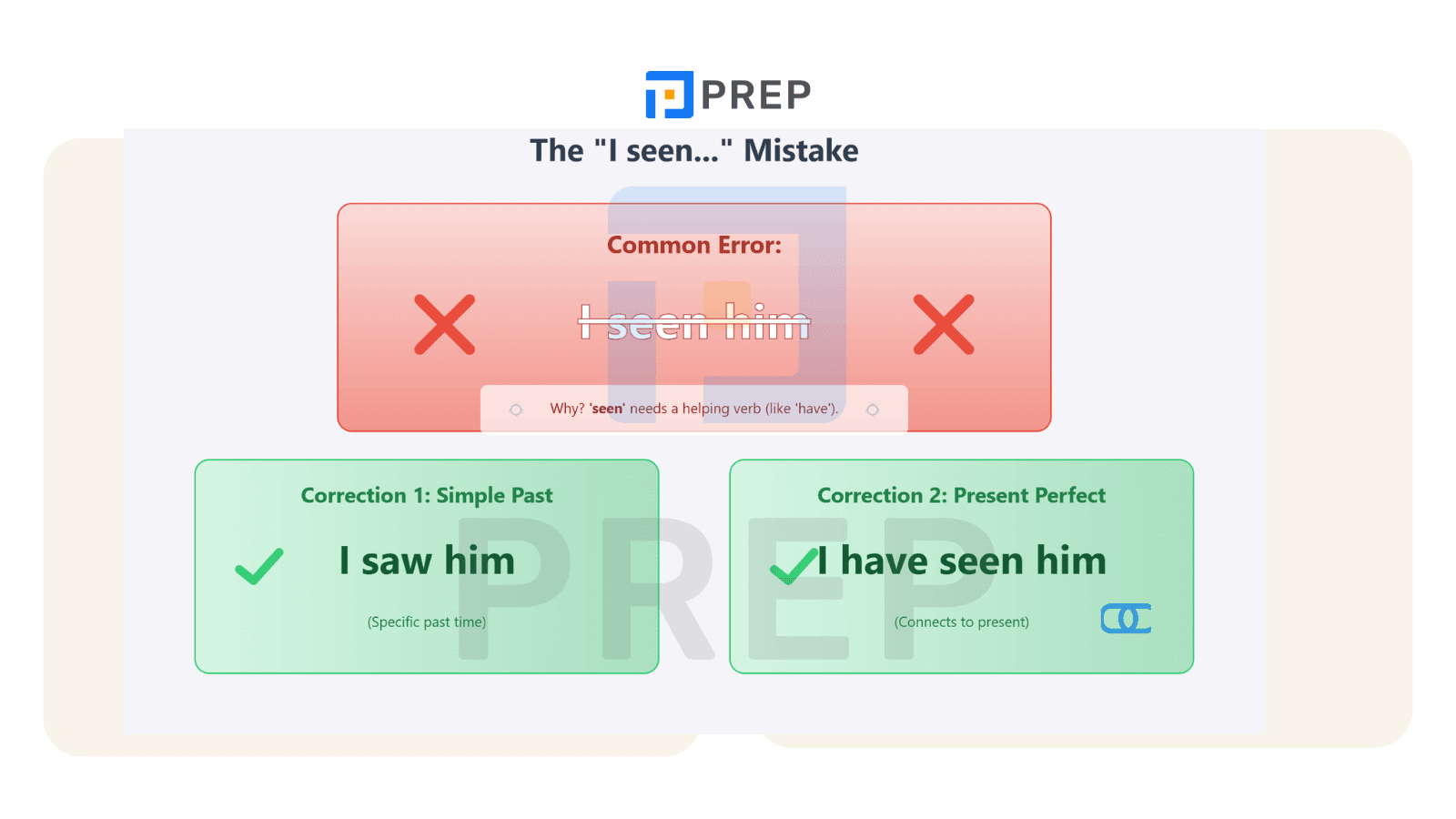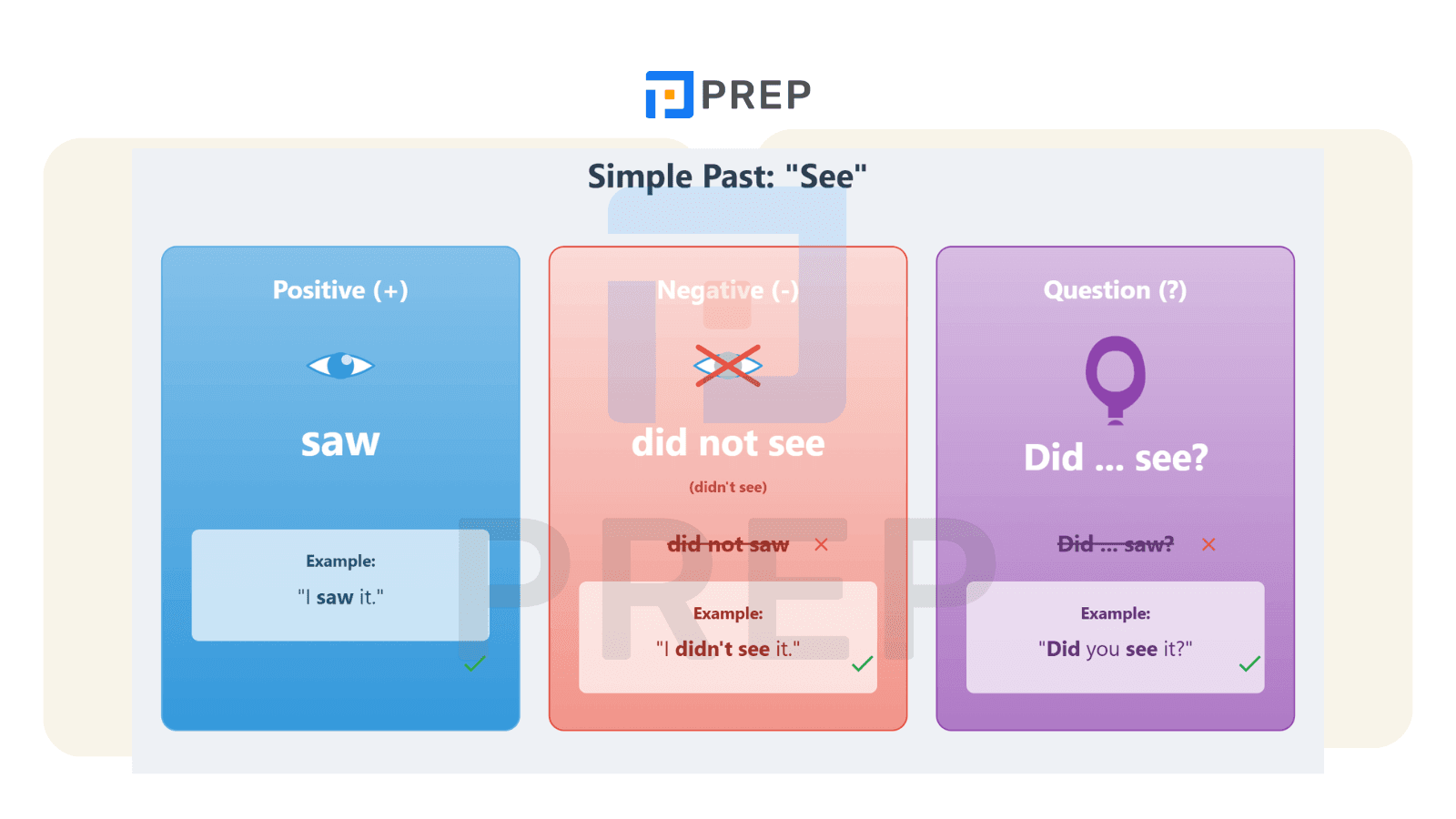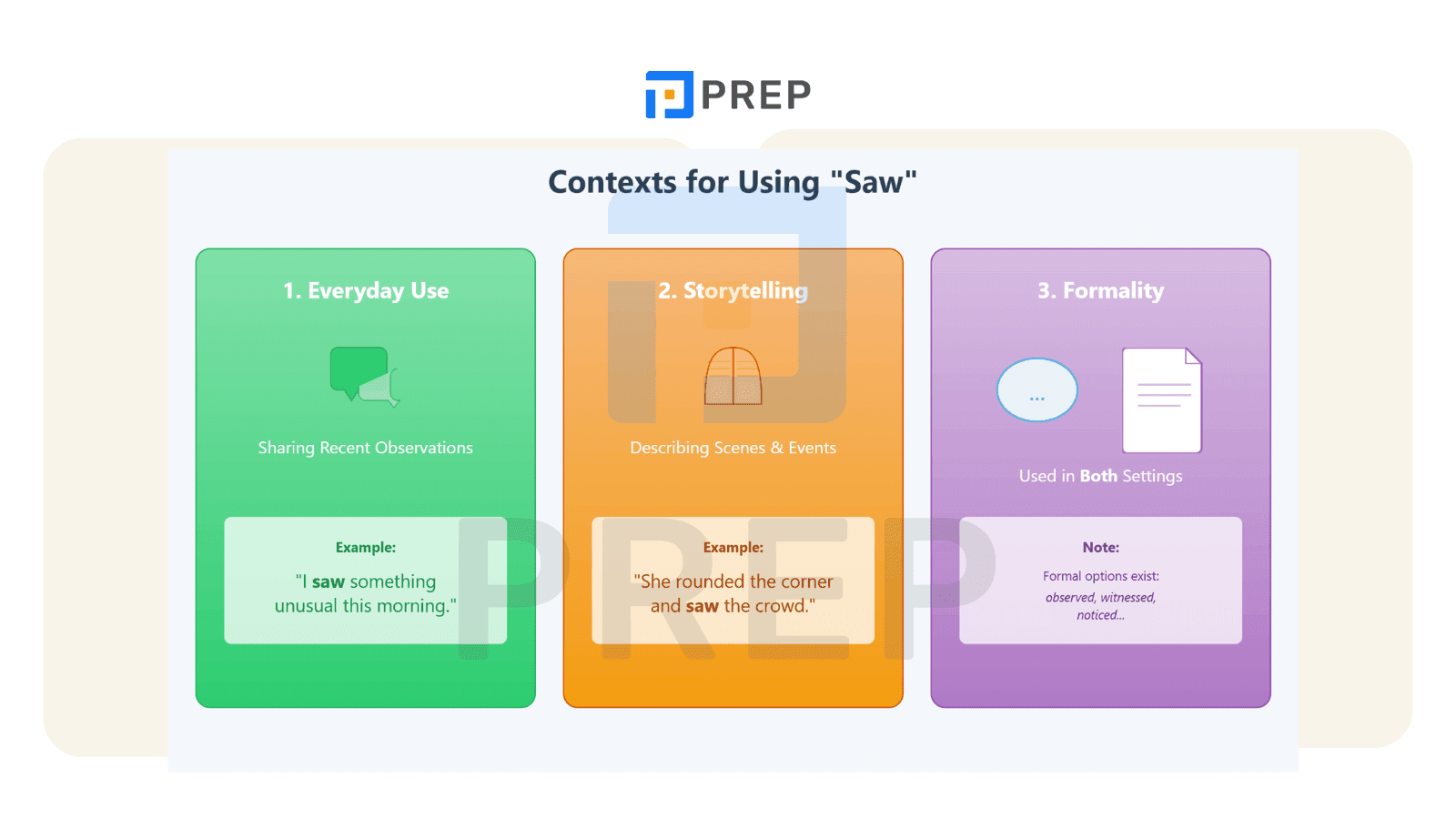Unlocking the Past Tense of "See" for confident English communication
This comprehensive article provides an in-depth exploration of the past tense of See. It meticulously distinguishes between "saw" (simple past) and "seen" (past participle), explaining their distinct grammatical functions, usage contexts, and common errors. The content offers detailed guidance on constructing proper sentences using these forms in affirmative statements, negatives, and questions, while addressing frequently asked questions and providing practical application examples across various communication contexts. The article serves as both an instructional guide and reference resource for English learners struggling with this fundamental but challenging aspect of English grammar.

I. Simple past tense of See
When discussing completed actions of seeing that occurred at specific moments in history, the past tense of see is "saw." Understanding the past tense of see is essential for clear communication in English.
Example: "I saw a rainbow yesterday."
"See" belongs to a special category of English verbs known as irregular verbs. Unlike regular verbs that conveniently add "-ed" to form their past tense of see (like "talk" becoming "talked"), irregular verbs transform in unique ways. This irregularity matters tremendously in your language journey because no systematic rule will guide you—you must internalize these forms through dedicated practice and exposure.
Consider the contrast between a regular verb like "walk" (which becomes "walked" in the past tense) and "see" (which becomes "saw"). This distinction represents one of the foundational challenges in English grammar mastery, and understanding the past tense of see places you on solid ground for advanced learning.
II. The critical distinction between "Saw" vs. "Seen"
The most frequent grammatical error involving the past tense of see occurs when people confuse the simple past and past participle forms - "saw" (simple past) with "seen" (past participle). Despite both forms relating to past actions, they serve entirely different grammatical functions and cannot be used interchangeably. Understanding this distinction between the past and past participle of see proves essential for correct English usage.
1. The principal parts of "See"
|
Form |
Grammatical Term |
Primary Use |
Example |
|
See |
Base Form (V1) |
Present tense, infinitives, imperatives |
"I see a bird." |
|
Saw |
Simple Past (V2) |
Expressing completed actions in the past |
"I saw a bird yesterday." |
|
Seen |
Past Participle (V3) |
Forming perfect tenses and passive voice |
"I have seen that bird before." |
2. Introducing "Seen": The Past Participle, NOT the Simple Past
The past participle of see represents a verb form that typically expresses completed action. In English, it combines with auxiliary verbs to create perfect tenses (have/has/had + past participle) or passive voice constructions (be/am/is/are/was/were + past participle). Past participles often indicate results, completed states, or actions experienced by the subject rather than performed by it.
"Seen" functions as the past participle of see. Unlike "saw," which can stand alone as a main verb, "seen" primarily operates in perfect tenses and passive voice constructions. The past participle cannot function independently as the main verb in a sentence—a fundamental rule that, when violated, immediately signals non-standard English usage.
3. When to use "Seen"
"Seen" must always be accompanied by an auxiliary verb to form grammatically correct sentences. This represents the single most critical rule for avoiding errors with the past tense and past participle of see. Without a helping verb, "seen" cannot function properly in standard English sentences, which explains why phrases like "I seen it" are considered grammatically incorrect.
3.1 Identifying Helping verbs: have, has, had, was, were, is, am, are, be, been
These auxiliary verbs combine with "seen" to create various tenses and constructions:
-
Have/has/had + seen (perfect tenses)
-
Was/were + seen (passive voice, past)
-
Is/am/are + seen (passive voice, present)
-
Be/been + seen (infinitive and perfect forms of passive voice)
3.2 Examples with Helping verbs
-
I have seen that documentary twice since its release. (present perfect)
-
The aurora borealis had been seen by thousands of visitors last winter. (past perfect passive)
-
His artwork was seen by critics as revolutionary for the period. (simple past passive)
-
This phenomenon has never been seen before in this region. (present perfect passive)
4. Comparison table about the past and past participle of See - "Saw" vs. "Seen"
|
Feature |
"Saw" |
"Seen" |
|
Grammar Term |
Simple Past Tense |
Past Participle |
|
Function |
Expresses completed past action |
Used with auxiliaries in perfect tenses and passive voice |
|
Time Reference |
Specific past time |
Can refer to unspecified past time, connect past to present, or form passive statements |
|
Auxiliary Verb Needed |
No – stands alone as main verb |
Yes – always requires a helping verb |
|
Example |
"I saw the movie last night." |
"I have seen the movie three times." |
5. The most common mistake between "Saw" and "Seen"
5.1 Using the past participle ("seen") without its required helping verb
This construction fails because it attempts to use "seen" (a past participle) as though it were a past verb of see. In standard English, past participles cannot function independently as the main verb in a sentence—they must be supported by appropriate helping verbs.
❌Incorrect: "I seen him yesterday."
✅Correction: "I saw him yesterday." OR "I have seen him." (depending on context)
The first correction employs the past tense of see for a completed action, while the second uses the present perfect to connect a past action to the present.
5.2 Using "Saw" with "Have/Has/Had"
Another frequent error involves incorrectly combining "saw" with perfect tense auxiliaries.
❌Incorrect: "We have saw that show."
✅Correction: "We have seen that show."
Remember that perfect tenses require the past participle of see (V3), not the simple past (V2).

III. Constructing sentences with "Saw"
Having established the difference between "saw" and "seen," let's examine how to incorporate the past tense of see correctly into various sentence structures across positive statements, negations, and questions.
1. Forming positive statements
In affirmative sentences, "saw" functions as the main verb and follows standard subject-verb-object syntax. This straightforward structure makes positive statements with the see in past simple relatively simple to construct.
Formula: Subject + saw + [object/details]
Example: "The team saw an opportunity to expand into the Asian market."
2. Forming negative statements: Using "Did Not See"
Creating negative statements with "see" in the past tense requires the auxiliary verb "did" combined with "not" followed by the base form of the verb—not the past tense form. This represents a critical distinction that often generates confusion.
Formula: Subject + did not (didn't) + see + [object/details]
Critical Point: Use the base form "see" (not "saw") after "did not"
Since "did" already carries the past tense marker, the main verb reverts to its base form. This pattern applies to all verbs, not just "see," when forming negative statements in the simple past tense of see with "did not."
Example: "We did not see the warning signs before the market shift." (Correct)
Example: "We did not saw the warning signs before the market shift." (Incorrect)
3. Forming questions: Using "Did [Subject] See?"
Questions in the simple past tense follow a similar principle to negative statements. They require the auxiliary "did," subject-verb inversion, and the base form of the verb—not the past tense form.
Formula: Did + Subject + see + [object/details]?
Critical Point: Use the base form "see" (not "saw") after "did"
As with negatives, "did" carries the past tense of see marker in questions, so the main verb must remain in its base form.
Example: "Did you see the announcement about the new policy?" (Correct)
Example: "Did you saw the announcement about the new policy?" (Incorrect)

IV. Practical application of using "Saw" in different contexts
Understanding how the past tense of see functions in various communication contexts helps solidify your grasp of its proper usage and versatility across different situations.
1. Using "Saw" in everyday conversation
In daily interactions, "saw" frequently appears when recounting recent experiences, sharing observations, or discussing past events. The simple past tense of see effectively communicates completed actions or observations from specific past moments.
Example: "I saw something unusual on my commute this morning—a falcon perched on the traffic light."
2. Using "Saw" in storytelling and narratives
The past tense of see plays a crucial role in narrative development, allowing writers and speakers to describe observations, realizations, and visual perceptions within story arcs. It helps establish chronology and perspective in both fiction and non-fiction accounts.
Example: "As she rounded the corner, she saw a crowd gathering near the main entrance."
3. Using "Saw" in formal vs. informal settings
"Saw" appears with equal acceptance in both formal and informal communication. However, formal writing sometimes employs alternatives like "observed," "witnessed," or "noticed" to add precision or stylistic variety.
Note: While the past tense of see remains standard across registers, formal academic or professional contexts might occasionally favor more specific verbs to convey nuanced shades of meaning or avoid repetition.

V. Frequently asked Questions (FAQs) about the past tense of See
These commonly asked questions address related aspects of "saw" usage and provide additional context for mastering this irregular verb pattern.
1. What exactly defines an "irregular verb" like 'see'?
Irregular verbs deviate from the standard pattern of adding "-ed" to form past tense and past participle forms. Unlike regular verbs (talk/talked/talked), irregular verbs follow unpredictable patterns that must be memorized individually. English contains approximately 200 irregular verbs, with "see/saw/seen" representing one of the more frequently used examples. These irregularities typically reflect historical language evolution rather than systematic grammatical rules.
2. Is "seed" or "sawed" ever a correct past tense form of "see"?
No, neither "seed" nor "sawed" functions as a valid past tense of see. "Saw" remains the only correct past simple of see. The word "sawed" relates exclusively to the cutting tool "saw" and describes the act of cutting something with this implement. This homonym relationship between the noun "saw" (cutting tool) and the verb "saw" (Past Tense of See) contributes to potential confusion.
3. How does the use of "saw" compare to "watched" or "looked at"?
While these verbs all involve visual perception, they carry distinct connotations regarding intention, duration, and focus. "Saw" often implies general visual perception or noticing, sometimes even accidentally or passively. "Watched" suggests sustained, deliberate attention over time. "Looked at" indicates directing one's gaze intentionally toward something, usually for a shorter duration than watching. Compare: "I saw a celebrity at the airport" (noticed) versus "I watched the celebrity sign autographs for fans" (observed over time).
4. What are some other common irregular verbs English learners struggle with besides "see"?
Several high-frequency irregular verbs pose similar challenges to "see/saw/seen" for English learners:
-
go/went/gone (completely different form in past tense)
-
eat/ate/eaten (vowel change pattern)
-
take/took/taken (vowel change pattern)
-
bring/brought/brought (consonant change)
-
do/did/done (vowel change with consonant simplification)
These verbs follow different irregular patterns but share the characteristic of unpredictable past forms that must be memorized rather than derived from rules.
Mastering the past tense of see resembles a journey rather than a destination. Each grammatical principle you master creates a foundation for more advanced learning. Regular practice with the past and past participle of see in various contexts will gradually transform conscious knowledge into intuitive application.
Immerse yourself in authentic English content, paying particular attention to how "saw" and "seen" appear in different contexts. Write practice sentences, speak aloud, and listen carefully to how native speakers distinguish these forms. Consider keeping a journal of your observations to track your progress over time.

Hi I'm Chloe, and I am currently serving as an Product Content Administrator at Prep Education. With over five years of experience in independent online IELTS study and exam preparation, I am confident in my ability to support learners in achieving their highest possible scores.
Comment
Premium content
View allPersonalized roadmap
Most read












